WEST FALMOUTH – On a recent Friday morning, an osprey swooped low over Crocker Pond in West Falmouth but then angled back up. No fish to be seen.
“They’re not awake yet,” said Mary Bunker Ryther, 50, who grew up on Crocker Pond and now lives just a quarter mile up the road in North Falmouth.
Her Norwich terrier Rogue positioned himself on the edge of the Bunker family dock and looked intently into the water, willing a fish to squiggle to the surface.
Nothing yet. Just clear water all the way to the bottom.
The pond off West Falmouth Highway (Route 28A) at the intersection of Thomas B. Landers Road is bound by the Bunker property taking up most of one side and Bourne Farm taking up most of the other. It is a serene place.
Ryther knows there are fish in the pond, always have been for the more than 65 years her family has lived next to it.
But she is concerned about the future and whether the abundant wildlife in and around the pond will be there for her grandchildren and their children.
It was just a year and a half ago that she and her siblings learned about a town plan to divert a treated wastewater plume through the pond.

An old painting shows Crocker Pond just beyond the Freeman farmhouse and barn. The Freemans still live on the pond and the 200-year-old barn still stands.
Crocker Pond is in the path of Site 7, as it is known, a disposal site for wastewater that will come from sewering homes around Little Pond in Teaticket, which is about 4 miles away.
The plan is for the wastewater from the Little Pond area to be pumped up to the West Falmouth Wastewater Treatment Facility, treated and then disposed of on a lot just south of Thomas B. Landers Road on Research Road about one-third of a mile away from Crocker Pond. The plume from the disposed wastewater will then travel via groundwater through Crocker Pond into Herring Brook, which is already classified as impacted, and out to Buzzards Bay.
The irony of the location of Site 7 is not lost on Ryther. She remembers attending a meeting in the old planning board office in Falmouth Town Hall about 25 years ago and hearing town officials and consultants saying that a plume from the then-proposed West Falmouth wastewater facility would have no ill effects on West Falmouth Harbor.
That prognosis turned out to be wrong.
The harbor has been damaged by a plume that travels through Mashapaquit Creek to the harbor. It is because of that damage that state environmental officials are requiring the town to find a new route for treated effluent from the Little Pond homes.
“My experience with wastewater is colored by what happened with West Falmouth Harbor,” Ryther said. And knowing the area, she believes that if Crocker Pond is damaged, other nearby water bodies like Mashapaquit Creek and therefore West Falmouth Harbor will likely be damaged too.
“They are supposed to be sparing West Falmouth Harbor but I don’t know that it really is,” she said of the town’s plan.
Committee Seeks Solutions
Eric T. Turkington, the former state representative, is chairman of the Town of Falmouth Water Quality Management Committee, the group that is proposing Site 7 for the disposal of the effluent from the sewering of the Little Pond area.

A historic photo of Crocker Pond and the Freeman property are on the cover of the book, “A History of West Falmouth.”
The committee is charged with putting together a plan to clean up the nitrogen pollution in Falmouth’s saltwater estuaries. Little Pond has been determined to be the worst impacted pond in Falmouth, Turkington said, and the plan is to sewer about 1,500 homes and businesses around the pond and pump the wastewater to the West Falmouth Wastewater Treatment Facility on Blacksmith Shop Road and treat it to a very high degree to remove nitrogen.
When it comes to nitrogen, Turkington said Falmouth’s plant can treat wastewater at a higher level than any other wastewater plant in Massachusetts.
“You treat to the highest level of treatment in Massachusetts. It has to go somewhere. You can’t shoot it in rockets to the moon. [Site 7] is the preferred site,” he said.
The town looked at 25 sites as to where to dispose of the treated wastewater that would have the least impact on surrounding water bodies and estuaries, Turkington said.
“There is almost no place in Falmouth where you can put it and not have it upstream of some estuary or pond,” Turkington admitted.
Because West Falmouth Harbor already gets a half million gallons a day in a plume, town officials were required by state environmental officials to find a disposal site that would not impact West Falmouth Harbor.
Turkington pointed out that the reason West Falmouth Harbor has been impacted is that the original plume consisted of wastewater that was not treated to the degree it is now. But the town has spent millions in upgrading the plant since then, and future impacts to the harbor will be considerably less, Turkington said.
Because of those past impacts, the state will not allow more effluent to go into the harbor. Town officials had to find a disposal site that met that criterion.
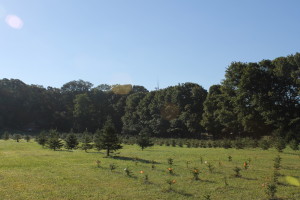
The Bunkers have an eight-acre tree farm on their property on Crocker Pond. The Bunker land is protected by a conservation restriction that prevents any further building of homes on the land. On the other side of the pond is the Bourne Farm property, which is owned by Salt Pond Areas Bird Sanctuaries and is also protected by a conservation restriction.
The site the town ended up with—Site 7—is just north of the existing treatment plant and is one-third of a mile to the east of Crocker Pond.
Turkington said the site will be studied extensively.
“We’re gong at it with science not an emotional issue. Everyone loves their own backyard and wants everything to stay the same. If science shows it will not affect the pond, then it’s a good site,” he said.
In the next month, the town will have data from numerous studies that can be shown to the neighbors, he said.
“This is probably the most analyzed proposal that the town has engaged in. We all agree we don’t want to impact that water body [Crocker Pond] or any water body. The issues are being vetted in great detail,” he said.
The biggest issue when it comes to pollution and freshwater ponds, Turkington said, is phosphorus. And so the principal issue that is being examined is how much phosphorus from the plume will make it to the pond.
“The results we’re getting . . . suggests none of it will get there for a long time, if ever,” Turkington said.
Turkington said he wanted to correct what he called “a falsehood” that the committee did not know about Crocker Pond and did not consider it when it chose Site 7.
The confusion came about, he said, because the original USGS maps that chart the groundwater flow in the area did not include Crocker Pond.
Turkington said the explanation for that is simple. “It wasn’t a map of ponds,” he said.
“We not going to promote a project that impairs Crocker Pond or any pond. We’re trying to improve an estuary that’s headed toward a stinking swamp, in the center of town,” he said, speaking of Little Pond. “The overall gist is we’re not impairing the pond. No one is promising no impact. What we’re promising is no negative impact in quality,” he said.
Backing & Forthing
The town’s Comprehensive Wastewater Management Plan needs to be approved by the state by January for financing.
The plan is now in the “backing and forthing” stage, Turkington said, with various scientists and consultants studying the plan.
At the April 2014 town meeting, the water quality committee is scheduled to come in with a capital plan for about $50 million that will include the collection—or sewering—system for Little Pond, the Site 7 infrastructure, and other methods for cleaning up the estuary, like widening the inlet.
The capital plan will not require new taxes because some old debt is being retired and this spending will replace it, Turkington said.
Caution is Key
Ronald Zweig, who is also a member of Falmouth’s Water Quality Management Committee, said that with environmental interventions, such as plumes, “you have to be very cautious.”
Site 7, he said is directly upstream of Crocker Pond with regard to groundwater flow. The estimate from the modeling is that 42 percent of the plume will flow through the pond or 270,000 to 280,000 gallons a day.
“From the analyses that have been done, there is some uncertainty and some degree of risk on how that phosphorus will impact freshwater bodies,” said Zweig, a retired biologist and ecologist who has experience with nitrogen modeling.
He said some analyses indicate there will be no problem and others dispute that and say there will be a problem when the plume hits the pond.
In addition to Crocker Pond, Zweig said Herring Brook is also downstream of Crocker Pond and could be impacted.
The rule of thumb on the speed of groundwater flow is one foot per day, which means there will be a period of three to four years before the plume hits the pond.
“It may be faster than that with the amount going in. That is the concern,” he said.
But Zweig said there are things that can be done within the plant’s treatment process, different types of sand or other materials can be put in the infiltration bed to capture the phosphorus.
But none of that is in the plan at this time and it would be expensive.
“I think this needs to be resolved in way that protects the future and that we have that obligation today to be sure that it is okay,” Zweig said of impacts on Crocker Pond. “There are lots of questions about this issue that need to be resolved.”
Zweig is on the board of the Coonamessett Farm Foundation, which is working with the town of Falmouth to clean up Little Pond with an alternative method: oysters.
Two and a half million oysters were put into the pond this summer. The shellfish filters nitrogen out of the water; just one of the alternative methods of pollution remediation the town is trying in addition to the sewering plan.
Out of Balance
Back at Crocker Pond, Ryther admires the view.
“My husband wanted me to be sure to tell you everything that lives in the pond,” Ryther said, and she began the list: snapping turtles, painted turtles, fresh water mussels—“the biggest one was over six inches long.”
Muskrats that live along the bank and eat the mussels. “You can see them swimming across the pond,” she said.
She knows all the fish. Hornpout, a kind of catfish, used to be abundant and now are rare, she said. They don’t have a chance against the large mouthed bass in the pond, likely imported from another pond.
There are also bluegills and pumpkin seed, a kind of sunfish. There are white perch, a native fish that indicates the pond is healthy, Ryther said. And yellow perch.
There are bullfrogs and fresh water crayfish the size of big shrimp.
And there are the osprey, sometimes two or three, that come looking for the bass.
There are green herons and great blue herons, and kingfishers, various ducks and cormorants.
As to what Ryther thinks might happen to the pond if the plume goes through it, she is circumspect.
“Loss of fish and wildlife. Something will be affected. Probably the level of oxygen. The ecosystem will be out of balance,” she said.
That loss will hit the Bunkers and others who care about the pond hard.
“We’d like it to be just like this for our grandkids. It’s nice for my mom to see six grandchildren using the property. I’d like to see my grandchildren enjoying it too. It won’t be like this if it’s damaged irresponsibly,” she said.
“That’s My Backyard”
Just down the shore a couple hundred feet from the Bunkers is the Freeman property. Todd Freeman, 42, grew up along the pond and with his wife Nichole is now raising his two children here. His parents still live next door in the house where he grew up.

Todd Freeman stands on his deck overlooking Crocker Pond. He is concerned about a plan to send a plume of treated wastewater through the pond in his backyard.
His property includes a 200-year old barn that appears in early photos of the pond. Growing up on the pond, he swam, boated and fished in its waters.
He first heard about the Site 7 plan last winter while watching a selectmen’s meeting. He was startled to hear someone mention Crocker Pond.
“I said, ‘excuse me, that’s my backyard,’” he said, upon hearing the name.
Freeman has heard town officials say the water will be treated to drinking water quality but he is skeptical.
“If it’s clean, I’d like to see the inspector taking a sip of the discharged water,” he said.
He said the ecosystem in the area, which includes a herring run is sensitive.
“I’m very concerned. I’ve been here 42 years. I’d like to keep it as healthy as it is now,” he said.
He agrees with Ryther that West Falmouth Harbor is too close not to get damaged from a plume that goes through Crocker Pond.
“West Falmouth Harbor is one mile away. Buzzards Bay is walking distance. If they are polluting the pond, it will pollute the others too,” he said.
George Heufelder, who is director of the Barnstable County department of health and the environment and a member of the Falmouth Board of Health, is a former member of the Water Quality Management Committee.
He is in charge of the Septic Systems Test Center on the Massachusetts Military Reservation where they test wastewater systems, including those that filter out phosphorus.
Wastewater contains about 8 to 12 miligrams per liter of phosphorus, he estimated. He has systems at the test center that remove phosphorus down to less than 1 miligram or lower per liter, he said.
Another option, he said, is to set up a kind of filter at the pond, called a reactive barrier, similar to what was installed at Ashumet Pond to stop a plume. But that would cost money.
Surprised & Disappointed
Another pond neighbor Dr. Peter Lind, 42, a pediatrician who moved to a house next to Crocker Pond 15 years ago, also has two children, two daughters who enjoy the pond.
When his daughters were young, they’d spend hours by the pond catching frogs and “sunnies,” or bluegills.
Lind said his claim to fame is he has never sent a child down to the pond with a fishing pole who hasn’t caught a fish.
“It’s definitely been awesome having the kids grow up on the pond,” he said.
He heard about the wastewater plan about a year ago from Ryther’s brother Andrew Bunker, who has been following the issue closely.
“I was so surprised and disappointed to hear our pristine pond would be on anyone’s list to possibly receive wastewater from a plant,” Lind said.
Lind said he is very interested in seeing baseline studies done of the pond to see if it can handle the impacts.
“We love where we live. We love the pond. . . . Just the thought this thing could be contaminated silently, just kills me,” he said.
– By Laura M. Reckford

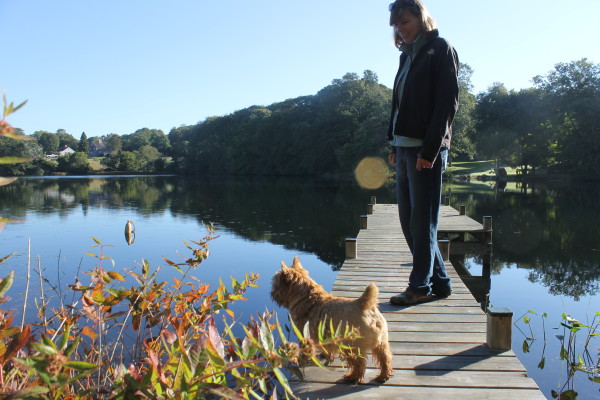
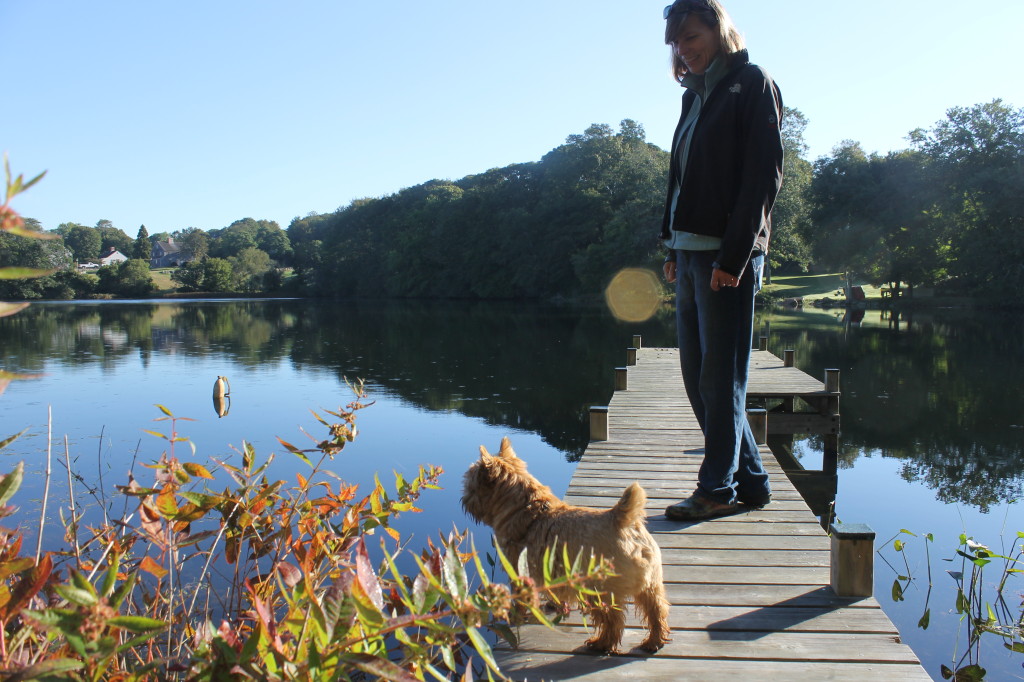
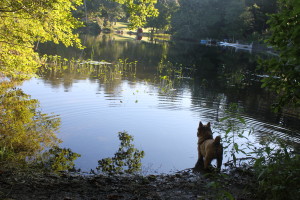










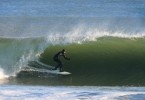


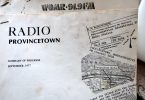
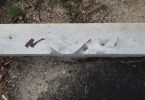



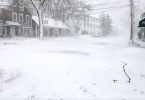


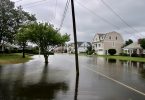
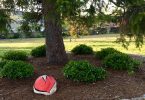






I HAVE VISITED THE PROPERTY ON MANY OCCATIONS AND FIND IT BREATH TAKING. THE HISTORY OF THE POND AND ALL THAT SURROUNDS IT MUST BE PRESERVED. DOES THE AREA QUALIFY FOR A HISTORIC DESIGNATION? I AM IN A WHEELCHAIR AND TRUELY APPRECIATE THE PURITY AS THE POND STANDS NOW. PLEASE KEEP IT HEALTHY SO THAT THE ANIMALS THAT LIVE THERE AND NEARBY CAN SURVIVE FOR THE NEXT 800 YEARS! DO ANY OF THE AREAS THAT THIS RUN OFF IS COMING FROM HAVE HISTORIC RELAVENCE IN THE SAME WAY THAT THIS POND DOES?
It is unfortunate that many of the affected West Falmouth residents have a growing feeling of being disenfranchised by their local governments in response to this issue. The Water Quality Management Committee has many residents skeptical. “You have to be very cautious” is the warning from member Ronald Zweig. Yet, Zweig throws caution to the wind regarding West Falmouth residents that are being negatively impacted by ‘noise pollution’ from the Town’s wind turbines. He campaigns for turbines to be operated 24/7 despite evidenced DEP noise violations. A Committee member, no matter the committee affiliation, displaying such “flip-flop” qualities and ill regard for neighbors, has many Crocker Pond residents questioning whether they’ll be next to be “thrown under the bus” due to municipal fiscal pressures.